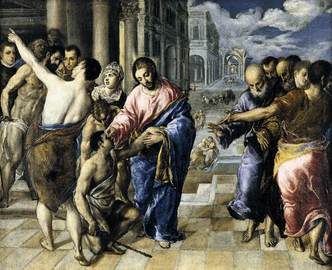Disability: Modern Understandings, Biblical Counter-Readings
April 07, 2017 • By Martin Wendte
A man in a wheelchair approaches a church. It is ten to ten on a Sunday morning: service-time. Slowly and laboriously, he opens the door, hardly managing to enter the building. What do you think this man expects from the service? That he will be able to leave the church walking by himself? That somebody will open the door for him and welcome him to the congregation, pointing to a sign that says that this is an “inclusive congregation”? Or that the pastor will emphasize that all human beings have got their limitations—smaller or bigger?
What does it mean to be “challenged,” physically or mentally—and what does the Bible say about it? Currently, three rival theories shape our understanding of disability. Interestingly enough, the Bible combines all three, with an emphasis on the third one.
Firstly, some say that disability is a bio-medical phenomenon. If a man needs a wheelchair to approach a church, he is disabled. What should be done to help him? He needs to be fixed, either by an operation or (if money or medical equipment is not available) by a miracle. A second school of thought says that it is society that excludes and disables some human beings. If a church does not have a ramp and an automatic door, then some people are excluded from participating in society. The man in the wheelchair does not need to be fixed—society needs to build more ramps. A third group emphasizes that all human beings are “challenged” in certain respects: some wear glasses, some use a wheelchair, and some are “blind” to the needs of their neighbor. The man in the wheelchair does not need an operation, or even a ramp—he needs open exchange about the smaller and bigger challenges everybody struggles with. Speaking more conceptually, some defend a bio-medical understanding of disability, some a social one, and some emphasize that disability is a cultural construct which is relative to a wider religious-cultural-political framework.
The New Testament is full of stories displaying that Jesus was a healer who helped blind, deaf, and lame human beings. But what exactly did he do in these instances?
Throughout the last 150 years, churches in the West have been used to reading the biblical healing stories from a bio-medical perspective. Jesus enables a person in a wheelchair to walk by himself. A quick glance into contemporary global Christianity displays that many churches, especially in the Global South, subscribe to this understanding of healing. These churches are successful because they heal human beings in a biomedical sense. In the West, this understanding of healing is often connected to a specific understanding of miracles: Miracles are miraculous interruptions of the normal, scientifically explainable cause of events and focus on the biomedical dimension of healing and health.
This reading of miracles and healing has more to do with the modern split between religion and medicine, more to do with a modern, rationalistic understanding of the world—than it has to do with the New Testament. In the last decade or fifteen years, a remarkable change within New Testament studies has taken place concerning how to read the “miracle stories” of Jesus. Rather than circling around questions based in the framework of a rationalistic understanding of miracles (Did this really happen? How did it happen?), scholars like J.J. Pilch in the US and von Brendemann and Stegemann in Germany follow the cultural understanding of health and disability in order to try to understand what they actually mean in their own context. Accordingly, they turn to cultural anthropology—especially to ethno-medicine—in order to understand Jesus the Healer in an appropriate way.
Ancient medicine differs from the Western medicine of our time. But there are also major differences between the “high” medicine of the Greeks and Romans of Jesus’ time and the kind of medicine Jesus practiced while he was healing. Jesus was something like a folk-healer, or a certain kind of a magician with Jewish background, who acted within an eschatological-apocalyptic horizon. This kind of medicine does not focus on health as concerned with bodies as objects in space and time. The focus is on the cultural-social-religious dimension of health and bodies. That is: a reading of healing and miracles from a cultural perspective reveals that Jesus’ own understanding and practice of healing focuses on a religious-cultural and social dimension, too. To put it more precisely: In Jesus’ healing activities, all three dimensions are connected, but the cultural-religious one is the decisive one.
It is likely that Jesus did change things on a biomedical level. He certainly did so in order to bring outsiders back into society, as we can see in a passage like Mk. 1, 40-45. But all his activities were integrated into the horizon of the inbreaking of the Kingdom of God. In order to perceive the Kingdom of God, the inner, spiritual eyes of human beings need to be opened, and this kind of healing is the true reason that Jesus came into this world (cf. e.g. Mk. 8, 21-28).
Accordingly, our man in a wheelchair could be the healthiest person in the congregation—or the one whose eyes are opened first. This should be able to happen in any congregation: efforts should be made to be inclusive, so that the man in the wheelchair can join the congregation. And only God knows how our wheelchair-bound man leaves the church...